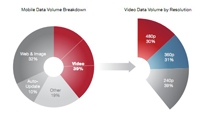Mobile video usage lower than originally predicted

Only 10 percent of mobile device owners are responsible for 90 percent of wireless network traffic, found a new study by Bytemobile, a mobile Internet platform provider.
Playing videos represented 40 percent of all traffic last year on worldwide wireless networks used by cell phones and other devices to access the Internet. That number is expected to grow this year to 60 percent, according to Bytemobile.
However, a relatively few heavy users are responsible for nearly all wireless network traffic. That user number indicates that smart phones are gaining in popularity and usage, but it will take years before they become major moneymakers for broadcasters and content providers.
Last month, Nielsen also reported that in the second quarter of 2010, only 10 percent of mobile users in the United States accessed video with their devices.
In a year-end report, Bytemobile found that the most prevalent type of video on wireless networks worldwide continues to be user-generated content available on YouTube and Google Videos. On average, this accounts for 48 percent of the total network video traffic.
On a per-user average, the company found that iPhone users generate more video traffic than Android device users. Also, the peak hours for data traffic on wireless networks have shifted from daytime to evening. This trend signifies a transition in mobile data consumption from business usage to residential, entertainment-based usage.
Mobile users, Bytemobile found, tend to opt for lower-quality videos to avoid loading times. Today, higher-resolution video is requested a third less often than lower-resolution video yet generates a similar amount of the total data traffic on the network: 31 percent compared to 39 percent.
The professional video industry's #1 source for news, trends and product and tech information. Sign up below.
This trend indicates that even a small increase in the number of users consuming higher-quality video will generate a significantly greater network traffic load.
